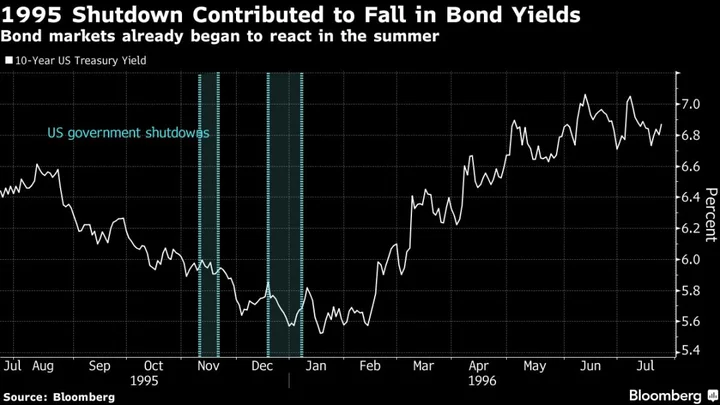A fresh fiscal showdown is brewing in Washington that threatens to complicate the Federal Reserve’s policy making and strengthen Fitch Ratings’ warning that self-inflicted wounds are tarnishing America’s standing in the global economy.
Congress left for an extended August recess without resolving simmering conflicts over spending and hot-button social issues, raising the risk of a government shutdown when federal funding runs out after Sept. 30. It’s the latest case of brinkmanship over the national budget that fueled Fitch’s move to strip US debt of its prized AAA status last week — a landmark decision that’s caused hand-wringing across Wall Street and Washington.
The credit rating company’s determination has emboldened Republicans to call on President Joe Biden and congressional Democrats to yield to their demands for fresh spending cuts.
Read More: Fitch’s US Downgrade Is Stoking the Very Fight It Warned Against
While the direct economic impact of a shutdown would likely be limited, it would come at “at a particularly inopportune moment,” warned Anna Wong, chief US economist for Bloomberg Economics.
The Fed will be making a key interest-rate decision in September and the increased likelihood of a prolonged shutdown could factor into that stance. During the 2018-2019 shutdown, many key economic indicators were delayed.
Meanwhile some 45 million Americans with student loans will have to resume making payments in October, potentially dampening consumer spending, while the prospect of a disruptive UAW strike against automakers that month is very real. Add the fact that the impact of Fed rate hikes will peak in the autumn, according to Wong, and the seemingly unstoppable US economy faces fresh hurdles.
Read More: US Recession Delayed, But Soft Landing Calls Overdone
“A prolonged shutdown could make it even more difficult for the Fed. That’s why I think markets could be nervous,” said Gennadiy Goldberg, senior U.S. rate strategist at TD Securities. “It could lead to the Fed potentially missing a Fall pivot point.”
The economic risk for the world’s largest economy shouldn’t be overstated, especially given the red-hot labor market. But any shutdown could dampen output at a vulnerable time. Moody’s Analytics economist Mark Zandi expects growth in the year’s final quarter to slow to “no more than 1%,” even without factoring the prospect of a government shutdown.
Goldman Sachs said in a research note on June 26 that a shutdown would likely subtract 0.2 percentage points from gross domestic product for each week it lasts.
Unlike Washington’s last fiscal crisis — the debt-limit fight earlier this year — a government shutdown wouldn’t risk a US default. Still, it adds another variable for investors in Treasury bonds, who have been whipsawed by everything this year from the uncertain inflation trajectory and the regional bank crisis to the increased supply of Treasury issuance.
There’s good news for those looking at history for a road map, though. Previous shutdowns around 2018 and 1995 sparked market gains as budget fights fed demand for haven assets.
“In this environment where the economic data is pointing to a slowdown in the pace of inflation and the Fed being close to the end of hiking, it could be a factor in favor of investing in government bonds of long duration,” said Michael Zezas, global head of fixed income research at Morgan Stanley, said of a potential shutdown.
In 1995, there were two separate shutdowns, extending into the first several days of 1996. The political struggle between President Bill Clinton and Republicans in Congress played out during a period of Federal Reserve interest-rate cuts intended to stimulate the economy. Market fears of a recession intensified due to the loss of spending from the government shutdown.
Long-term government bond yields dropped, raising the value of securities held by investors. The yield on 10-year Treasuries fell from 6.61% in August to as low as 5.52% in January 1996. The bond market did not reverse course until February of the next year.
Trump Shutdown
In 2018, a shutdown began that lasted 35 days after President Donald Trump and Congress reached an impasse over border wall funding. Fears of a recession again caused convulsions in the bond markets. While the shutdown began in December, yields fell in anticipation beginning in November amid Trump’s shutdown threats.
Investors are becoming conditioned to fiscal fights like the shutdown and increasingly regard them as “performative theater,” Isaac Boltansky, Managing Director and Director of Policy Research at BTIG said. That could diminish the size of any bond rally, he said.

